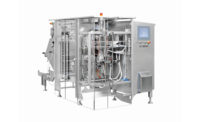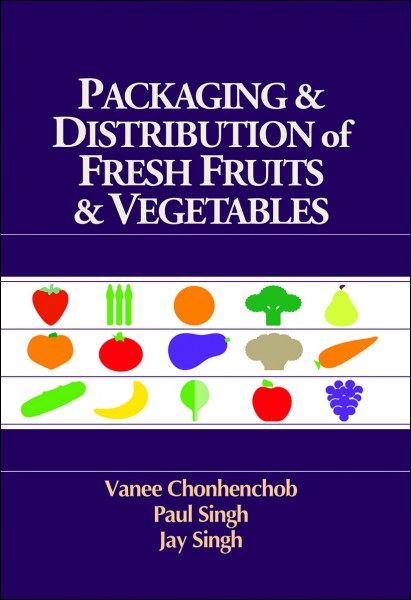New form/fill/seal equipment offers packaging flexibility
Machines accommodate a wide range of packaging options at high speeds.




The latest form/fill/seal (FFS) packaging systems are more versatile and more adaptable to different bag types, film types and bag sizes than previous versions. That is good news as consumers continue to demand smaller, on-the-go, resealable packages for their snacks and baked goods, and retailers demand packaging formats that bring convenience to their customers.
In the coming years, demand for more flexible vertical form/fill/seal (VFFS) machines will be high because of their small footprint and associated space-saving qualities, according to Tom Egan, vice president of industry services, PMMI, Reston, VA. “However, VFFS machines must improve flexibility as they currently do not run stand-up pouches well enough, both zippered and unzippered.”
Horizontal form/fill/seal (HFFS) machines are traditionally more flexible, as they can run pillow-shaped packages and zippered and unzippered stand-up pouches more efficiently than VFFS machines, Egan adds. “HFFS machines also can run pre-made pouches. The downside to HFFS is high machine footprint and a tendency to generate a lot of excess waste.”
Equipment innovations
New FFS systems can accommodate a wide range of packaging options at high speeds, and provide packaging formats that bring convenience to shoppers. Triangle Package Machinery Co., Chicago, offers the Model XYRJ, a VFFS bagger that features a rotatable sealing jaw that allows users to run pillow-style bags, 3-sided seal bags, gusseted bags and a stand-up pouch, with optional longitudinal zipper and/or transverse zipper. Because it can run a variety of package styles, the Model XYRJ is suitable for products such as baking mixes and powders, nuts, cereal and oatmeal, as well as crackers and other snacks.
Triangle recently enhanced the machine with optional features like ultrasonic sealing and longitudinal or transverse zipper applicators. “Our zipper applicator can apply a zipper ultrasonically or with heat. The combination ultrasonic back seal and zipper applicator offers several advantages over a heat-applied zipper, including the ability to run more zipper profiles and apply zippers at higher speeds. This in turn helps bakery/snack producers run more SKUs and increase production,” says Kim Magon-Haller, marketing manager.
TNA North America, Dallas, recently introduced the tna robag 5, which operates at speeds of up to 300 bags per minute. The company calls it the industry’s first ultra-high-speed VFFS system. Features include a precision scale capable of combining different products while offering fast and accurate product transfer with minimum waste. “The integration of ultrasonic back seal technology allows it to overcome the thermal transfer limitations of traditional heat seal methods and provide superior seal integrity, even at high speeds,” says Steven Wolfe, general manager.
Together with a new date coder, these features enable the tna robag 5 to operate at high speeds from a single tube, while reducing the amount of waste, ensuring that each bag meets high quality standards, Wolfe adds. “The tna robag 5 also is equipped with a real-time controller that reduces maintenance costs and downtime by supplying manufacturers with instant, highly detailed system diagnostics.”
Bosch Packaging Technology, New Richmond, WI, recently introduced the entry-level flow wrapper Pack 102, which can pack up to 150 products per minute. The machine is suitable for small and mid-sized businesses looking to automate, and run small batches for seasonal promotions or new market launches. The Pack 102 can flexibly wrap products of various sizes, ranging from small and flat to very large and tall, either individually or grouped on cards or trays. “It is suitable for all bakery products that require horizontal flow wrapping, ranging from cookies, crackers and bread, all the way to cakes and pastries,” says Jason D’Arcy, VFFS product manager.
In addition, Bosch recently unveiled the SVE 3220 DZ, a new version of the SVE 2520 DZ VFFS, which is adaptable to larger formats up to 320 mm high. The machine produces seven popular bag styles: pillow, gusseted, block bottom, corner seal, full corner, 3-sided, as well as Doy and Doy Zip with its patent-pending zipper applicator. “The premium quality, attractive shape and size of the bags help drive visibility and consumer preference for food products at point-of-sale,” D’Arcy notes.
Reiser, Canton, MA, recently added the Variovac Optimus for smaller, entry-level applications. It features its Rapid Air System, which maximizes the distribution of film into critical areas, such as corners. This allows package engineers to choose thinner forming films with potential cost savings of up to 20 percent. The Rapid Air System eliminates the need for preheating film and produces high-quality forms and seals at 13 cycles per minute.
Zip Pak, an ITW Co., Carol Stream, IL, recently introduced the 360 tdi Series, a compact transverse zipper applicator for VFFS machines. “The applicator is capable of running narrow or wide flange zippers, is compact and space-saving, and allows for faster operation and accurate registration,” says Art Malcomson, global director of sales.
WeighPack Systems, Montreal, part of the Paxiom Group, offers VFFS machines range from entry-level to high-speed. “Our VerTek models can produce vertical pouches ranging from 2 inches wide to 24 inches wide,” says Nicholas Taraborelli, vice president at WeighPack. “The XPdius Elite can produce up to 100 bags per minute. These vertical baggers are suitable for chips, nuts, dried fruits, cookies, chocolates, candies and a variety of other dry, non-stick food products.”
Sanitary design
Improved sanitary design is a major driver of equipment innovation.
“The Optimus is constructed of heavy-duty stainless steel and is engineered to meet the highest standards of hygiene. Designed for complete washdown, the machine can be cleaned quickly and safely,” says Guenter Kuhl, packaging specialist, Reiser.
Campbell Wrapper Corp., De Pere, WI, has introduced the RefleXion wrapper, which features two opposite hand-flow wrappers mounted back-to-back on a common frame. The RefleXion allows more wrappers to fit into a smaller area. The company offers several sanitation levels—powder-coated frames up to full stainless steel for washdown. “Many end users are requesting washdown solutions in applications where washdown was not required in the past,” says Chuck Cucullu, vice president. “The driving force seems to be allergen issues related to multiple products run on the same line. The critical issue is reducing the time required for allergen cleaning.” He adds that today’s machines have fewer parts and are easier to disassemble and clean than machines from a few years ago.
All baggers in the Triangle X-Series feature a stainless-steel film cage, minimal welding and no hollow structures—only solid side frames and solid cross frames. Cross members are turned 90°, and all edges are finished and ground smooth. “These features facilitate water and product shedding, as well as ease of cleaning. And, thanks to a pivoting control box and open frame design, our bagging machines are accessible on all four sides,” Magon-Haller notes.
Looking ahead, fully integrated packaging solutions that comprise bagging and case packing equipment are likely to increase in demand as they offer significant benefits in terms of compact design and performance, Wolfe says. For example, TNA North America has developed a packaging concept that will enable users to reach their output targets with fewer components.
“The tna performance 5.0, comprised of the robag 5 VFFS system and ropac 5 case packer, will increase throughput and offer one of the industry’s smallest footprints,” Wolfe predicts. “This integrated solution will enable bakery/snack producers to increase productivity, while requiring fewer system components to maintain output when moving to smaller bag sizes.”
Looking for a reprint of this article?
From high-res PDFs to custom plaques, order your copy today!











